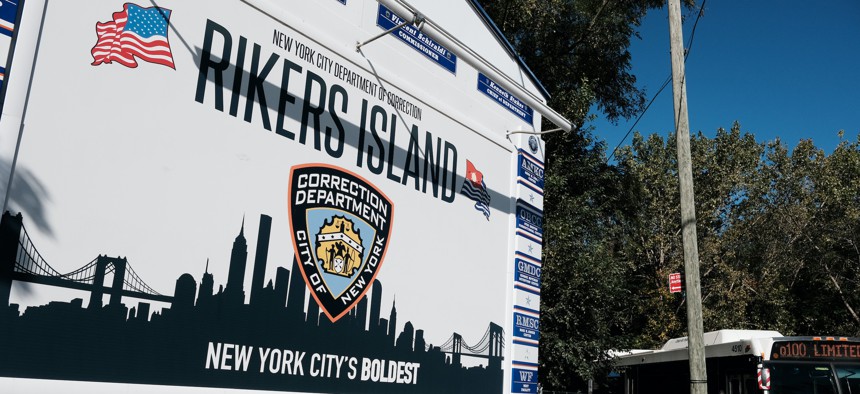New York City
Dispute over hiring wardens outside of NYC Department of Correction threatens city’s control over Rikers
The federal monitor appointed to oversee management of the city’s troubled jail complex said the city is unwilling to agree to alternatives to recruiting from within.

Rikers Island Spencer Platt/Getty Images
A dispute over regulatory hurdles that the New York City Department of Correction said would prevent it from making requested reforms to Rikers Island has become a point of contention between the city and the federal monitor threatening a takeover of the jail system. Namely, the hiring of wardens outside of the department.
The federal monitoring team appointed as part of a court battle over the inhumane conditions at the jail complex previously recommended hiring wardens from outside of the department as a crucial step in introducing new perspectives of those who have not risen through the ranks at the DOC. “They want fresh thinking in there and people who know more than the Rikers way,” Executive Director of the Independent Commission on New York City Criminal Justice and Incarceration Reform Zachary Katznelson explained.
But the Department of Correction is currently prohibited from doing so under state and city laws, and is hesitant to seek special permission from the court to work around this barrier, the federal monitoring team said in a letter to Southern District Judge Laura Swain on Friday. “It would require overriding civil service law and the unions expectations and norms . . . that would be a serious, serious shift, and I think the broader question is: what precedent does that set for unions across the city?” Katznelson said. The warden’s union did not respond to a request for comment from City & State.
The dispute was highlighted as a prominent issue in the most recent batch of court filings regarding a potential federal takeover of Rikers Island – something the monitoring team threatened in April while ordering the Department of Correction to come up with a plan to avoid receivership. The initial plan was filed in late May, and the monitors were complimentary of the department’s willingness to address long-sought reforms, including cracking down on abuse of sick leave among correction officers, structural changes to the chains of command and reducing missed medical appointments among detainees. The federal monitors expressed doubt, however, that the reforms were feasible.
Swain gave the monitoring team and the DOC two weeks to come up with a revised plan, and during that time, the monitors seem to have lost some confidence in the DOC. “The parties and monitoring team have engaged in extensive discussions regarding the development of a provision that would require the city to make applications to the court to abrogate legal barriers when they arise,” Federal Monitor Steve Martin wrote to Swain. “Unfortunately, agreement on such a provision could not be reached and therefore it is not included in the action plan.”
The Legal Aid Society, which represents the jail population in the lawsuit, called the city’s solution to the warden issue a “nonsensical structure” that involves hiring both civilian leaders and uniformed wardens with separate chains of command in a separate letter to Swain. The letter also noted that the federal monitors said previously that the new structure is “simply insufficient.”
The federal monitoring team made clear in the May hearing that the initial action plan, which was compiled by the department in consultation with the federal monitoring team, was incomplete. The monitors said that while the plan lacked specifics, it laid out a framework for overhauling the most troubled aspects of the jail complex. Swain also expressed concerns about the “lack of specificity.”
In the plan submitted Friday, the city added a section in which it promised to regularly provide information and data on incidents of violence, in-custody deaths, staffing levels and disciplinary cases to the monitoring team.
“The primary change to this revised plan is that we will be providing more tracking data on key elements of the consent judgment than ever before, on a regular basis, which was a primary complaint raised at the last hearing. Ultimately, the proof of our Action Plan will be in its results, many of which are already trending in the right direction,” the city law department said in a statement.
Mayor Eric Adams, in a statement, noted the progress the DOC has made since he appointed Commissioner Louis Molina in January, including fewer officers out on sick leave, reductions in slashings and stabbings, along with fewer use of force incidents and assaults on staff.
“As our updated, detailed plan makes clear, with the proposed time, we have a strategy to aggressively untangle the dysfunction that has plagued the island and set it on a path of real and enduring reform. We know that there is much more difficult work to be done, and the city is committed to doing it,” the mayor said.
Katznelson noted that there are still some admissions, particularly in regards to mental health issues.
“People with mental illness, especially serious mental illness, is a significant segment of the (Rikers) population that the plan doesn't really grapple with. It's just going to have to be dealt with outside of the plan,” he said.
It will likely be months before the fate of the federal receivership is finalized, pending a series of court hearings and filing deadlines. The city still has a shot at maintaining control of the jail complex, and Martin’s team has instructed the DOC to begin implementing the action plan immediately.
“The monitor really does, I think, have a lot of confidence in Commissioner Molina himself as somebody who's thoughtful, who really wants change . . . and obviously, the key question is, does he have enough power to do it?” Katznelson said.

